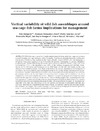Identificador persistente para citar o vincular este elemento:
https://accedacris.ulpgc.es/jspui/handle/10553/49616
| Título: | Vertical variability of wild fish assemblages around sea-cage fish farms: Implications for management | Autores/as: | Dempster, Tim Fernandez-Jover, Damian Sanchez-Jerez, Pablo Tuya, Fernando Bayle-Sempere, Just Boyra, Arturo Haroun, Ricardo J. |
Clasificación UNESCO: | 310504 Protección de los peces 251092 Acuicultura marina |
Palabras clave: | Aquaculture Fish farm Wild Fish Impact Assemblage, et al. |
Fecha de publicación: | 2005 | Editor/a: | 0171-8630 | Publicación seriada: | Marine Ecology - Progress Series | Resumen: | Wild fish were counted in 4 depth-related strata (bottom, midwater, cage and surface) around 3 floating sea-cage fish farms (Altea, Campello, Guardamar) along the Spanish coastline and 2 farms (Los Cristianos, San Andrés) in the Canary Islands. Almost 200000 wild fish belonging to 53species were seen; representatives of Sparidae (8 species), Carangidae (6 species), Mugilidae (5species) and Chondrichthyid rays (7 species) were commonly observed. At all 5 farms, 1 to 3 taxa accounted for >74% of the abundance and >94% of the biomass of aggregated wild fish. Abundances (5.7 to 162 times) and biomasses (42 to 1728 times) of wild fish were higher in the cage stratum at the 3 Mediterranean farms than at the bottom. In contrast, abundances and biomasses of wild fish at the Canary Island farms were highest at the bottom at San Andrés and highest at the surface at Los Cristianos. Large differences in the sizes of associated fish existed among farms, with low percentages of fish >20 cm total length at Guardamar, Los Cristianos and San Andrés (11 to 25%) compared to Altea and Campello (81 to 95%). However, the greatest proportions of large fish were present in the cage stratum at each of the 5 farms. This variability suggests that assemblage structure and aggregated biomass of wild fish at farms cannot be predicted prior to their installation, causing uncertainty in modelling of nutrient dispersal. Further, the sedimentation ‘footprint’ of temperate sea-cage fish farms may vary depending on (1) the species and biomass of associated wild fish, and (2)where these fish are distributed in the water column. As wild fish consume lost feed and assimilate nutrients, we suggest that coastal managers prohibit fishing of large planktivorous species at farms to fully harness their ability to ameliorate benthic impacts. | URI: | https://accedacris.ulpgc.es/handle/10553/49616 | ISSN: | 0171-8630 | DOI: | 10.3354/meps304015 | Fuente: | Marine Ecology Progress Series [ISSN 0171-8630], v. 304, p. 15-29 |
| Colección: | Artículos |
Los elementos en ULPGC accedaCRIS están protegidos por derechos de autor con todos los derechos reservados, a menos que se indique lo contrario.
